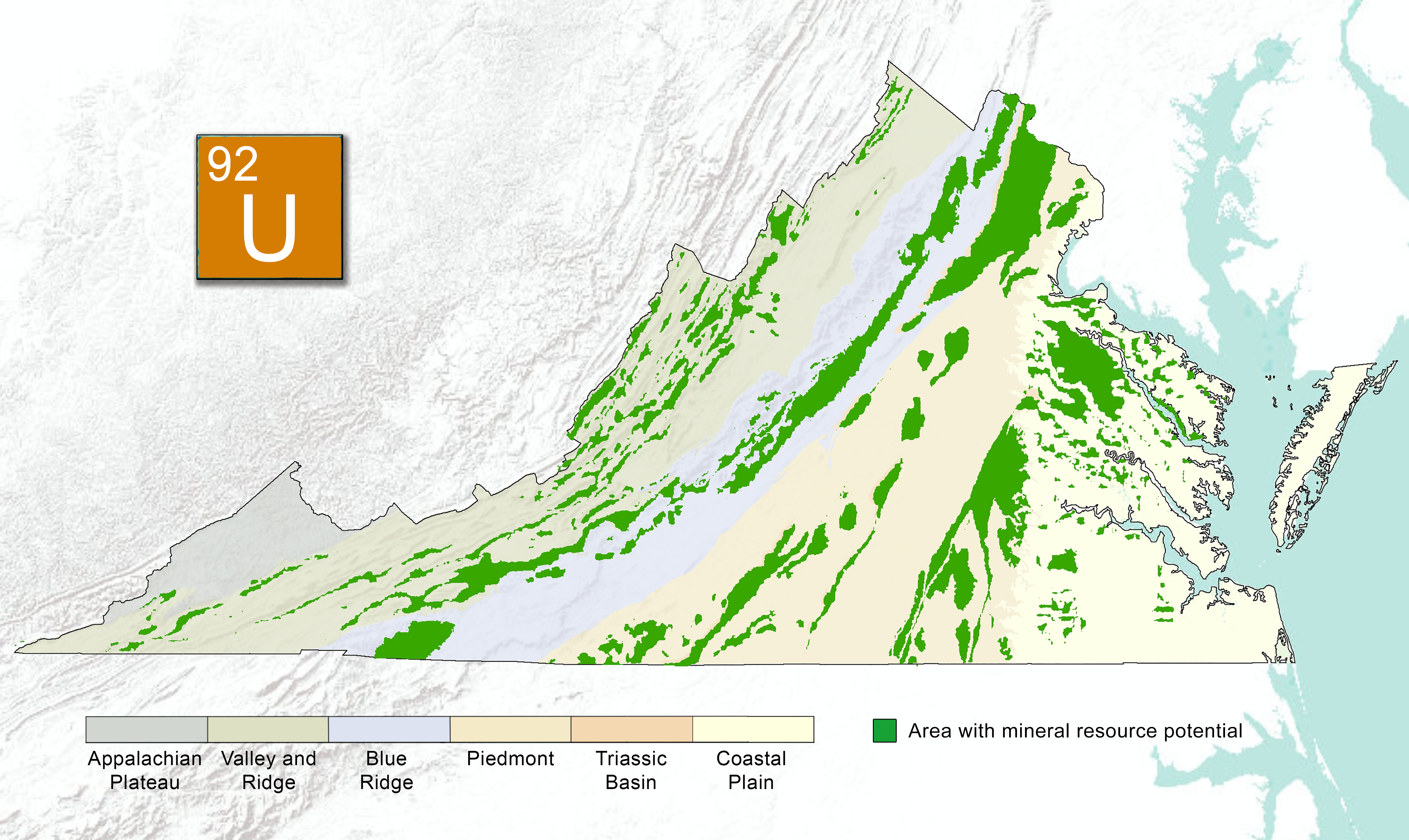Characteristics of Uranium
Uranium is a dense metal with the chemical symbol U. As a pure metal, uranium is heavy and metallic. With a specific gravity of about 18.7, natural uranium is nearly as heavy as gold (about 19.3). It is a poor conductor of electricity, malleable, and ductile. Uranium is naturally radioactive, emitting gamma radiation. It exists in nature in several isotopic forms, such that the nucleus of the uranium atom contains 92 protons, but a variable number of neutrons, which together add up to the atomic mass.
The main isotopes are U-238, U-235, and U-234. Most of the weight of natural uranium consists of atoms of U-238 (99.3 percent), while U-235 (0.7 percent) constitutes most of the remainder, and U-234 (0.006 percent) only a very small amount. That U-235 is naturally fissionable, meaning that the nucleus may be split with a consequent release of energy, makes this specific isotope valuable today as a fuel in nuclear power generation. Uranium occurs in trace amounts in over 215 mineral species including oxides, phosphates, carbonates, sulfates, arsenates, and silicates. The main ore minerals, listed in Table 1, typically contain more than about 45 percent U.
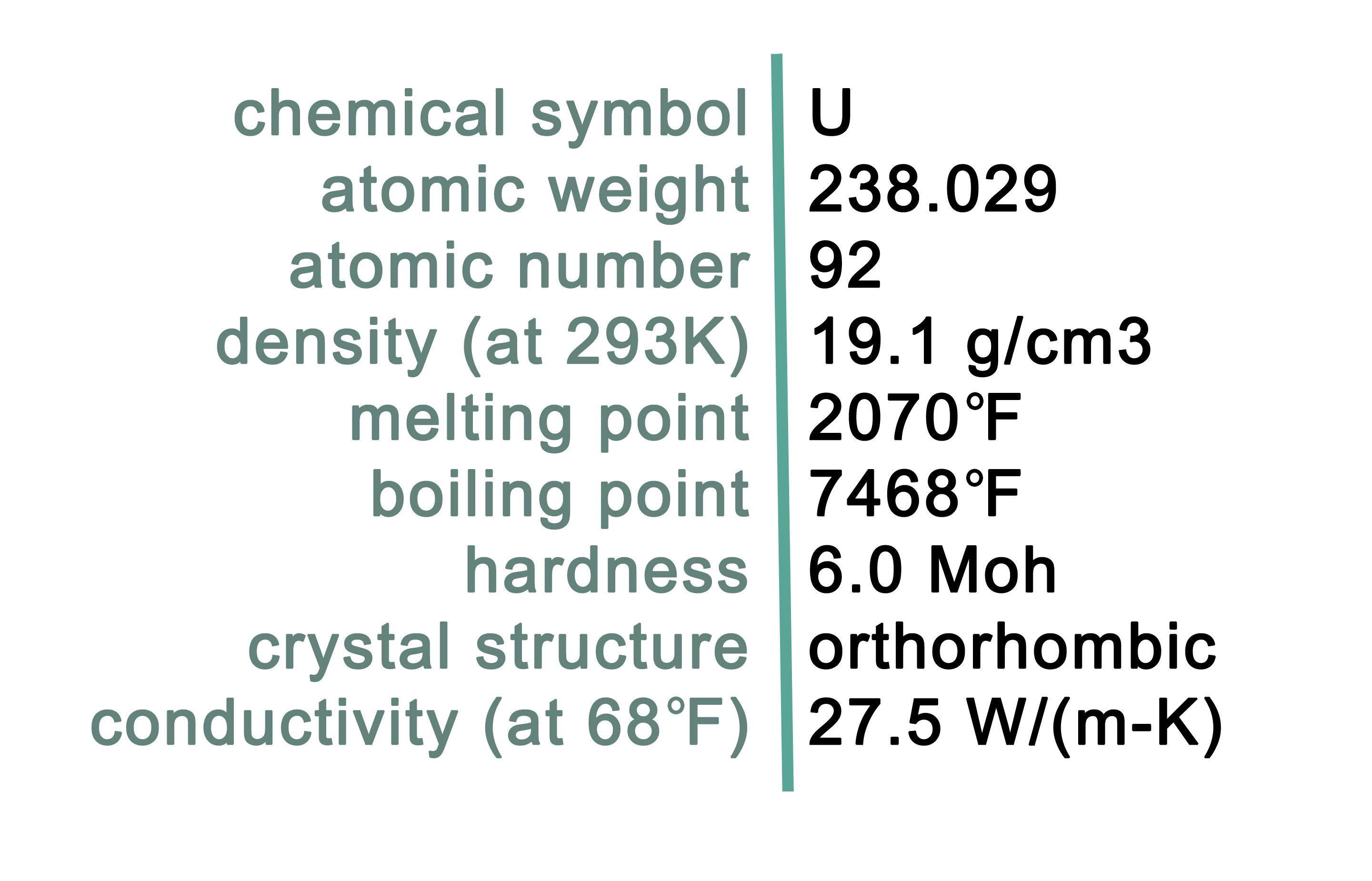
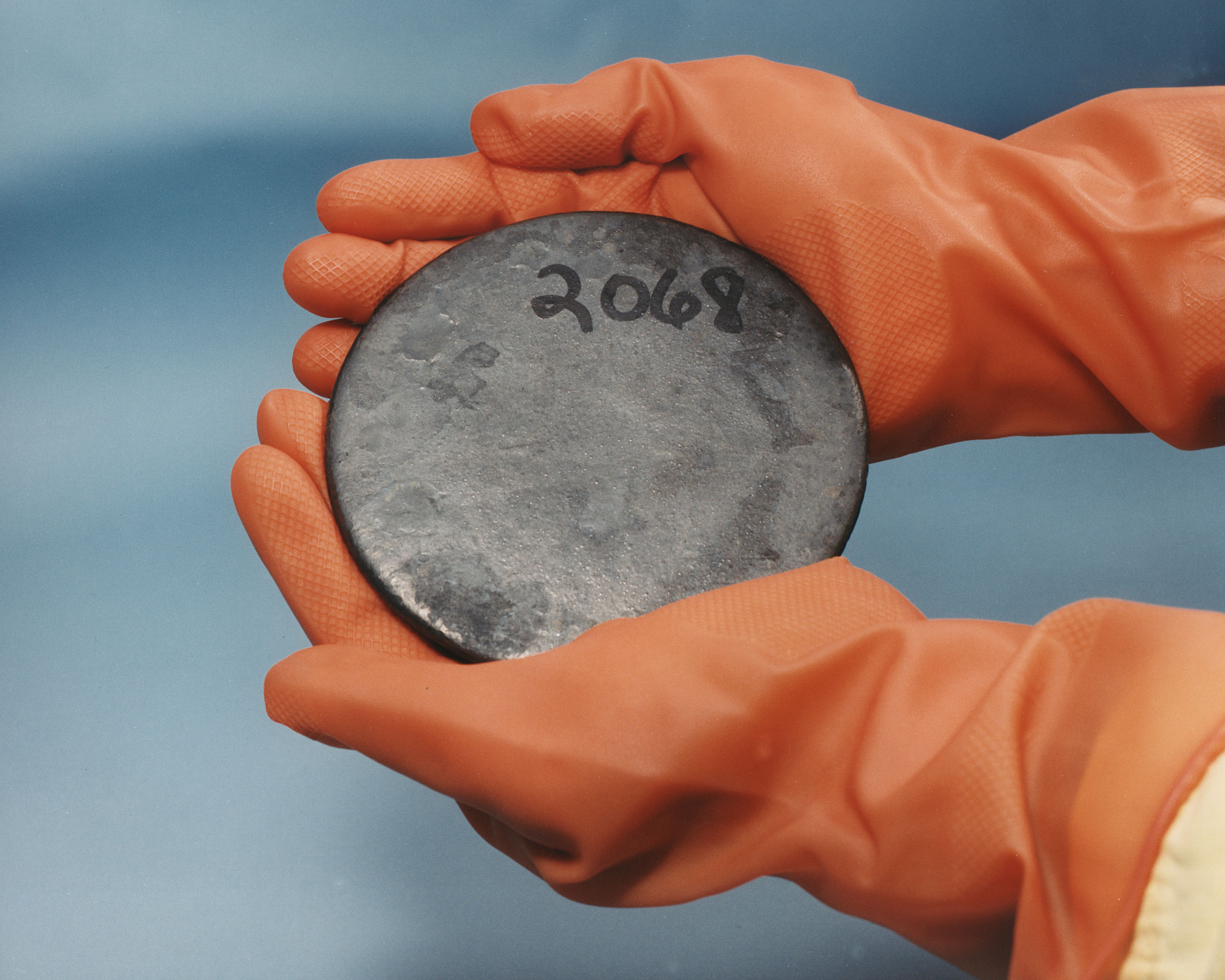
| Mineral Name | Chemical Formula | Specific Gravity | U % |
|---|---|---|---|
| Uraninite / pitchblende | UO2 | 11.0 gm/cc | 88.15 |
| Finchite | Sr(UO2)2(V2O8)● 5H2O | 2.61 gm/cc | 59.9 |
| Carnotite | K2(UO2)2(VO4)2● 3(H2O) | 5.07 gm/cc | 52.77 |
| Coffinite | U(SiO4)0.9(OH)0.4 | 5.44 gm/cc | 72.63 |
| Tyuyamunite | Ca(UO2)2(VO4)2● 6(H2O) | 3.80 gm/cc | 51.85 |
| Autunite | Ca(UO2)2(PO4)2● 11(H2O) | 3.22 gm/cc | 48.27 |
| Torbernite | Cu(UO2)2(PO4)2● 11(H2O) | 3.22 gm/cc | 48.00 |
Table 1: Minerals containing the element Uranium
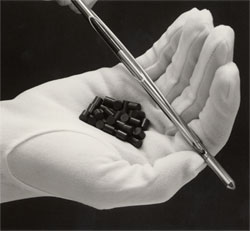
Uranium pellets are safely contained within
zirconium-coated nuclear reactor fuel rods
Uses of Uranium
Uranium is essential in domestic metallurgical applications that serve aerospace, defense, and energy technologies (Fortier and others, 2018). In the past uranium was commonly used as a colorant in ceramic glazes and glass with colors ranging from orange-red to yellowish-green. The element has been used as an oxide catalyst in the production of plastic as well as in the electrical industry for the manufacture of UV light electrodes and resistors in incandescent lighting. The use of uranium compounds by early photographers in the mid-1800s led to the discovery of spontaneous radioactivity.
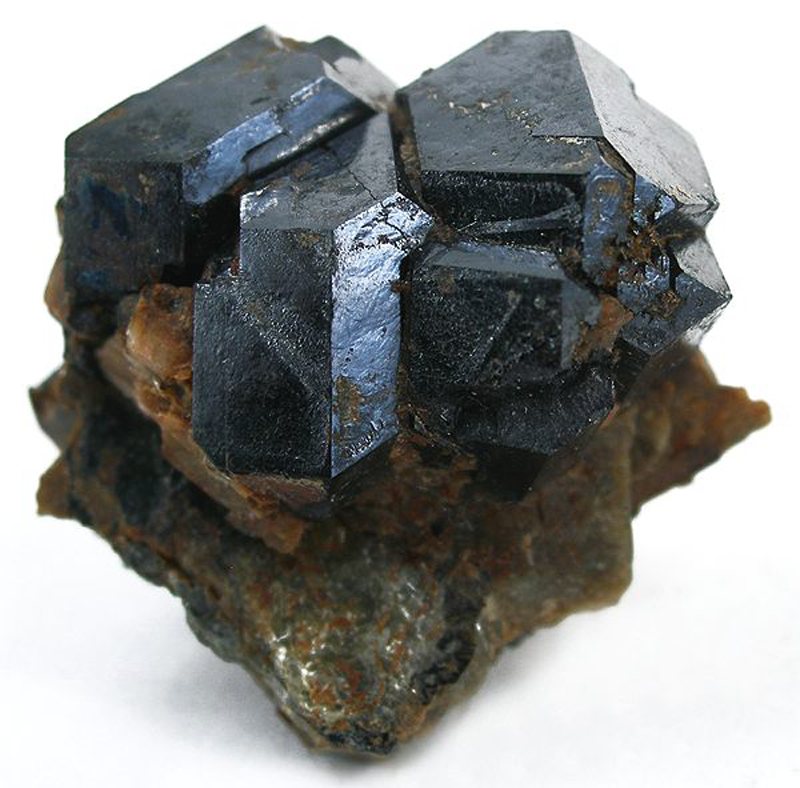
A uraninite crystal. Photo credit:
Robert M. Lavinsky, iRocks.com
Uranium Geology
Uranium occurs naturally in over 200 mineral forms within rocks, soils and water. It is common in igneous, metamorphic, and sedimentary rocks. Typically found in very low concentrations ranging from less than 1 part per million (ppm) to about 8 ppm, uranium in the Earth's crust averages about 2.5 ppm while the concentration in seawater is about 0.003 ppm. Uranium is a trace element in many of the common rock-forming minerals. Uranium-bearing minerals may form within pegmatites or hydrothermally-altered veins, or from the weathering of other uranium-bearing rocks. Uranium is often associated with sulfide deposits containing nickel, iron, zinc, lead, and copper ores.
| Mineral System | Deposit Type | Geologic Provinces |
|---|---|---|
| Chemical weathering | Surficial uranium | Coastal Plain |
| Meteoric recharge | Sandstone hosted | Valley and Ridge |
| Basin Brine | Unconformity and breccia-pipe related | Piedmont, Blue Ridge |
| Marine chemocline | Black shale, phosphorite | Valley and Ridge, Coastal Plain |
| Metamorphic | Metasomatite, shear/cataclasite-hosted | Blue Ridge, Piedmont |
| Magmatic | Peralkaline igneous-related, vein (granite-related) | Piedmont, Blue Ridge |
| Iron-oxide-apatite (IOA) and Iron oxide copper gold (IOCG) | Albitite uranium, hematite breccia | Piedmont, Blue Ridge |
Table 2: Prospective uranium mineral systems, deposit types (Hofstra and Kreiner, 2020), and geologic provinces in Virginia
Uranium in Industry
Although the United States maintains a supply of uranium in the National Defense Stockpile, the United States is approximately 95 percent import reliant from several countries including Canada, Kazakhstan, Australia, and Russia. Uranium has been mined in the United States since 1949, and continues today, although only about 10 percent of uranium comes from domestic sources. Uranium is mined or processed in Nebraska, Wyoming, Utah, New Mexico, Texas, and South Dakota. Concerns related to the mining and production of uranium include the release of uranium into soil, air, and water where contamination is a serious health issue.
Uranium has never been mined in Virginia, however uranium-rich bedrock exists across the Commonwealth. Recent geochemical sampling and mapping of natural radioactivity by aerial and ground survey methods has greatly assisted in our understanding of the distribution of uranium-enriched bedrock. In the Blue Ridge and Piedmont provinces, these formations typically include silica-rich meta-igneous rocks such as granite, alkali-rich plutonic rocks, and pegmatites. In the Valley and Ridge province, carbonaceous black shales often contain relatively elevated uranium content. Similar uranium enrichment in black shales deposited in the Mesozoic basins has also been noted. Uranium enrichment may also be associated with the deposition of phosphorites in the Coastal Plain. Surface weathering of these rocks may provide sources for mobile uranium (for example, uranium-bearing minerals entrained in the sands of stream sediments), yet the natural processes that concentrate uranium-bearing minerals in potentially mineable deposits are complex and have occurred very rarely in geologic time.
The earliest exploration in Virginia for uranium and associated minerals began in the early 1950s. A publication entitled "Uranium in Virginia" (Stow, 1955) describes the interest at that time in finding uranium in Virginia. Based upon the previously known models of uranium deposits, the greatest potential for discovery of commercial resources was considered to be in the western portion of the state. In the late 1970s and early 1980s, the National Uranium Resource Evaluation (NURE) program was conducted under the federal Atomic Energy Commission, exploring areas throughout the eastern U.S. for evidence of radionuclides. The program employed exploration techniques such as aerial radiometric surveys, stream sediment sampling and other surface measurements. The results of these studies helped set the foundation for mapping the distribution of uranium-enriched bedrock in Virginia.
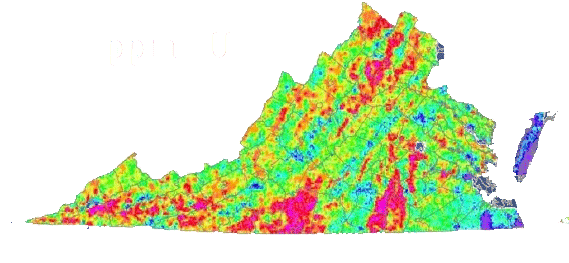
National Uranium Resource Evaluation (NURE) aeroradiometric data showing color-shaded eU (ppm).
Source: USGS OFR 2005-1413
Pittsylvania County
The largest unmined uranium deposit in the United States is Coles Hill, in Pittsylvania County. Several mining companies conducted uranium exploration programs and land leasing in Virginia during the 1970s, resulting in the discovery of the Swanson deposit by Marline Uranium Corporation at Coles Hill in 1978. Marline drilled approximately 256 exploration holes at Coles Hill between 1980 and 1982.
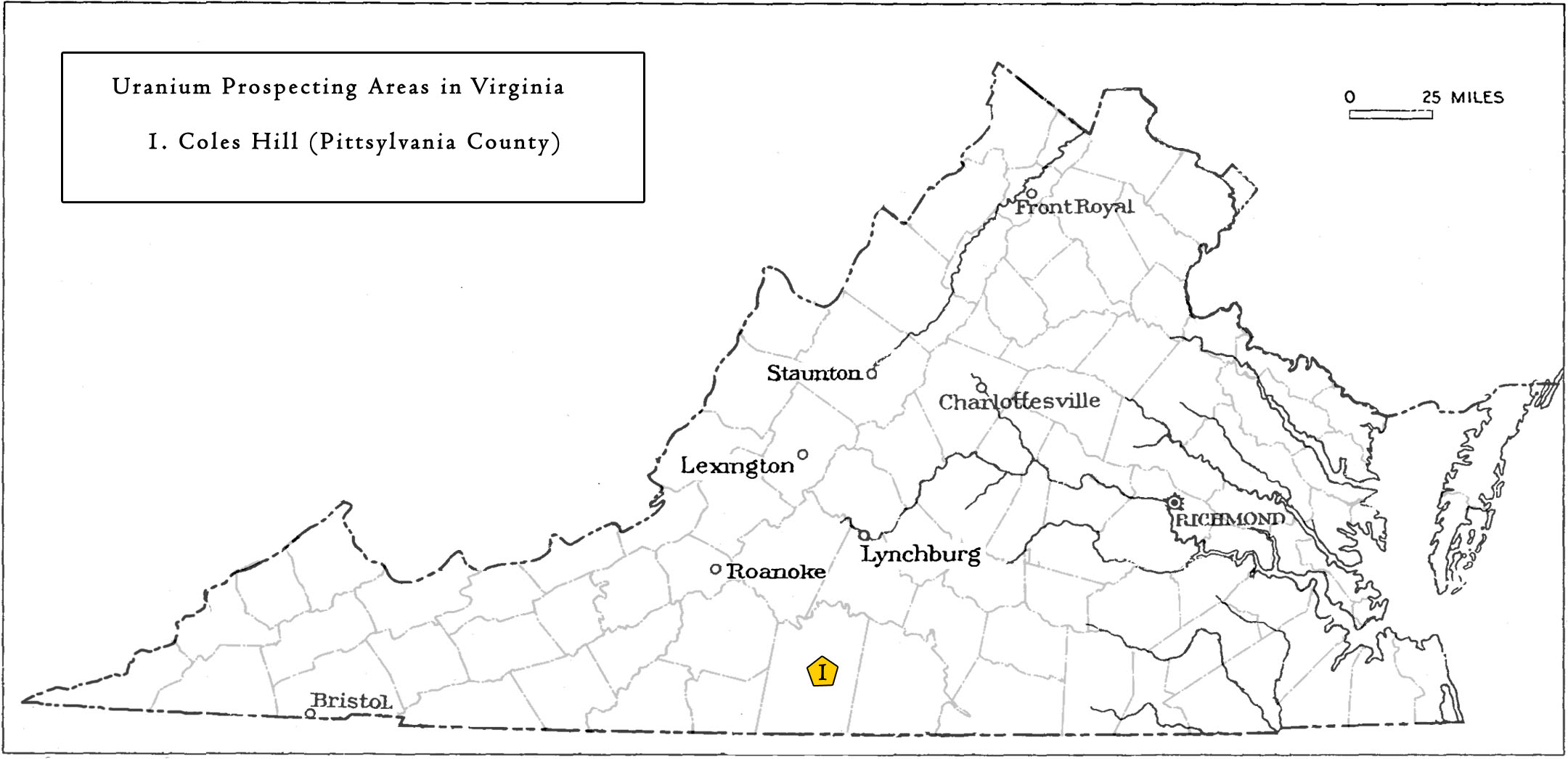
Locations prospected for uranium in Virginia
In 1982, Virginia enacted Title 45.1, Chapter 21 of the Code of Virginia which governs uranium exploration and also included a moratorium on uranium mining, requiring that a program to regulate mining be established by statute before the Commonwealth could accept uranium mining permit applications. The moratorium remains in place today. In 1983, the Uranium Administrative Group (UAG) was created and authorized to contract with consultants to conduct studies evaluating the costs and benefits of uranium mining at specific locations in Pittsylvania County, and report its findings to the Virginia Coal and Energy Commission in December 1983. In January 1984, the Coal and Energy Commission accepted the UAG recommendation to continue and expand the scope of studies under the oversight of the newly created Uranium Task Force (UTF), which reported its findings on October 1, 1984 (final report). Not long after that report was released, the market price for uranium decreased substantially and the outlook for future demand appeared to be limited. Based on anticipated production costs, the Coles Hill deposit was no longer considered a viable commercial mining enterprise and Marline Corporation dropped their mineral leases.
In 2005, uranium prices begin to increase and interest in the Coles Hill site was renewed. In 2007, Virginia Uranium, Inc. (VUI) applied for and received an exploration permit to further explore the Coles Hill deposit. The general requirements of the uranium exploration statue are found here.
Legislation was introduced in the 2008 session of the General Assembly to establish a legislative commission to consider whether uranium mining should occur in the Commonwealth. As a result, several studies were conducted to review public health and environmental issues associated with uranium mining and milling culminating in the 2012 report issued by the Uranium Working Group that included staff from DMME, the Department of Environmental Quality (DEQ) and the Virginia Department of Health (VDH). For more information concerning these studies, please visit the archived UWG website.Selected References
Bailey, W.M., 1984, Uranium and Thorium Mineralization of the Northern Half of the Horseshoe Mountain Quadrangle, Nelson County, Virginia: Virginia Division of Mineral Resources Virginia Minerals, v. 30, n. 4, p 37-46.
Baillieul, T.A. and Daddazio, P.L., 1982, A Vein-Type Uranium Environment in the Precambrian Lovingston Formation, Central Virginia: Virginia Division of Mineral Resources Publication 038, p 1-12.
Fortier, S.M., Nassar, N.T., Lederer, G.W., Brainard, J., Gambogi, J., and McCullough, E.A., 2018, Draft Critical Mineral List - Summary of Methodology and Background Information - U.S. Geological Survey Technical Input Document in Response to Secretarial Order No. 3359: U.S. Geological Survey Open-File Report 2018-1021, 15 p.
Henika, W. S., Thayer, P.A, 1983, Geologic Map of the Spring Garden Quadrangle, Virginia: Virginia Division of Mineral Resources Publication 048, scale 1:24,000.
Hofstra, A.H., and Kreiner, D.C., 2020, Systems-Deposits-Commodities-Critical Minerals Table for the Earth Mapping Resources Initiative: U.S. Geological Survey Open-File Report 2020-1042.
Johnson, S.S., 1979, Radioactivity Surveys: Virginia Division of Mineral Resources Virginia Minerals, v. 25, n. 2, p 9-14.
Johnson, S.S., 1991, Natural Radiation: Virginia Division of Mineral Resources Virginia Minerals, v. 37, n. 2, p 9-14.
Johnson, S.S., Gathright, T.M., and Henika, W.S., 1979, Gamma-Ray Spectrometry and Geologic Mapping: Virginia Division of Mineral Resources Virginia Minerals, v. 25, n. 3, p 17-23.
Krason, J., Johnson, S.S., and Marr, J.D., 1988, Geochemistry and Radioactivity in the Powhatan Area, Virginia: Virginia Division of Mineral Resources Publication 078, p 1-60.
Lasch, D.K., 1988, On Radon: Virginia Division of Mineral Resources Virginia Minerals, v. 34, n. 1, p 1-4.
Le Van, D. C., 1990, Energy Resources and Facilities in Virginia: Virginia Division of Mineral Resources Publication 100, scale 1:500,000.
Marr, J. D., 1984, Geologic Map of the Pittsville and Chatham Quadrangles, Virginia: Virginia Division of Mineral Resources Publication 049, scale 1:24,000.
Stow, M.S. 1955, Uranium In Virginia: Virginia Division of Mineral Resources, Virginia Minerals, v. 1, n. 4, p 1-4.
